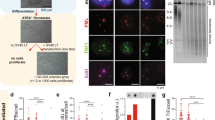Abstract
Senescence naturally limits the proliferation of mammalian cells in culture, possibly by shortening the telomere regions at the ends of chromosomes during cell division1,2. In support of this idea, introducing TERT, the catalytic subunit of telomerase — the enzyme that maintains chromosome ends — into certain cell types can extend their lifespan and potentially immortalize them3,4. It has been proposed that treatment with exogenous TERT might be useful for cell-based therapies by allowing indefinite expansion of normal human cells without damaging their genomes5,6. But we show here that TERT-driven cell proliferation is not genoprotective because it is associated with activation of the c-myc oncogene.
This is a preview of subscription content, access via your institution
Access options
Subscribe to this journal
Receive 51 print issues and online access
$199.00 per year
only $3.90 per issue
Buy this article
- Purchase on Springer Link
- Instant access to full article PDF
Prices may be subject to local taxes which are calculated during checkout

Similar content being viewed by others
References
Harley, C. B., Futcher, A. B. & Greider, C. W. Nature 345, 458– 460 (1990).
Harley, C. B. Mutat. Res. 256, 271–282 (1991).
Bodnar, A. G. et al. Science 279, 349–352 (1998).
Wang, J., Xie, L. Y., Allan, S., Beach, D. & Hannon, G. J. Genes Dev. 12, 1769– 1774 (1998).
Morales, C. P. et al. Nature Genet. 21, 115– 118 (1999).
Jiang, X. R. et al. Nature Genet. 21, 111– 114 (1999).
Sun, P., Dong, P., Hannon, G. J. & Beach, D. Science 282, 2270–2272 (1998).
Wu, K. J. et al. Nature Genet. 21, 220– 224 (1999).
Alitalo, K. et al. Biochim. Biophys. Acta 907, 1– 32 (1987).
Kiyono, T. et al. Nature 396, 84–88 (1998).
Foster, S. A. & Galloway, D. A. Oncogene 12, 1773–1779 (1996).
Kim, N. W. et al. Science 266, 2011– 2015 (1994).
Author information
Authors and Affiliations
Corresponding author
Rights and permissions
About this article
Cite this article
Wang, J., Hannon, G. & Beach, D. Risky immortalization by telomerase. Nature 405, 755–756 (2000). https://doi.org/10.1038/35015674
Issue Date:
DOI: https://doi.org/10.1038/35015674
This article is cited by
-
Non-canonical roles of canonical telomere binding proteins in cancers
Cellular and Molecular Life Sciences (2021)
-
A prospect of cell immortalization combined with matrix microenvironmental optimization strategy for tissue engineering and regeneration
Cell & Bioscience (2019)
-
Characterization of ductal carcinoma in situ cell lines established from breast tumor of a Singapore Chinese patient
Cancer Cell International (2014)
-
The catalytic and the RNA subunits of human telomerase are required to immortalize equid primary fibroblasts
Chromosoma (2012)
-
Actions of human telomerase beyond telomeres
Cell Research (2008)
Comments
By submitting a comment you agree to abide by our Terms and Community Guidelines. If you find something abusive or that does not comply with our terms or guidelines please flag it as inappropriate.



